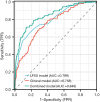Lung field-based severity score (LFSS): a feasible tool to identify COVID-19 patients at high risk of progressing to critical disease
- PMID: 39444869
- PMCID: PMC11494559
- DOI: 10.21037/jtd-24-544
Lung field-based severity score (LFSS): a feasible tool to identify COVID-19 patients at high risk of progressing to critical disease
Abstract
Background: Coronavirus disease 2019 (COVID-19) still poses a threat to people's physical and mental health. We proposed a new semi-quantitative visual classification method for COVID-19, and this study aimed to evaluate the clinical usefulness and feasibility of lung field-based severity score (LFSS).
Methods: This retrospective study included 794 COVID-19 patients from two hospitals in China between December 2022 and January 2023. Six lung fields on the axial computed tomography (CT) were defined. LFSS and eighteen clinical characteristics were evaluated. LFSS was based on summing up the parenchymal opacification involving each lung field, which was scored as 0 (0%), 1 (1-24%), 2 (25-49%), 3 (50-74%), or 4 (75-100%), respectively (range of LFSS from 0 to 24). Total pneumonia burden (TPB) was calculated using the U-net model. The correlation between LFSS and TPB was analyzed. After performing logistic regression analysis, an LFSS-based model, clinical-based model and combined model were developed. Receiver operating characteristic curves were used to evaluate and compare the performance of three models.
Results: LFSS, age, chronic liver disease, chronic kidney disease, white blood cell, neutrophils, lymphocytes and C-reactive protein differed significantly between the non-critical and critical group (all P<0.05). There was a strong positive correlation of LFSS and TPB (Pearson correlation coefficient =0.767, P<0.001). The area under curves of LFSS-based model, clinical-based model and combined model were 0.799 [95% confidence interval (CI): 0.770-0.827], 0.758 (95% CI: 0.727-0.788), and 0.848 (95% CI: 0.821-0.872), respectively.
Conclusions: The LFSS derived from chest CT may be a potential new tool to help identify COVID-19 patients at high risk of progressing to critical disease.
Keywords: Coronavirus disease 2019 (COVID-19); computed tomography (CT); prediction.
2024 AME Publishing Company. All rights reserved.
Conflict of interest statement
Conflicts of Interest: All authors have completed the ICMJE uniform disclosure form (available at https://jtd.amegroups.com/article/view/10.21037/jtd-24-544/coif). The authors have no conflicts of interest to declare.
Figures





Similar articles
-
The association between liver fibrosis scores and chronic kidney disease.Front Med (Lausanne). 2023 Jan 30;10:1046825. doi: 10.3389/fmed.2023.1046825. eCollection 2023. Front Med (Lausanne). 2023. PMID: 36793875 Free PMC article.
-
Impact of liver fibrosis score on the incidence of stroke: A cohort study.Liver Int. 2022 Oct;42(10):2175-2185. doi: 10.1111/liv.15359. Epub 2022 Jul 16. Liver Int. 2022. PMID: 35789194
-
CT Quantification and Machine-learning Models for Assessment of Disease Severity and Prognosis of COVID-19 Patients.Acad Radiol. 2020 Dec;27(12):1665-1678. doi: 10.1016/j.acra.2020.09.004. Epub 2020 Sep 21. Acad Radiol. 2020. PMID: 33046370 Free PMC article.
-
[Analysis of the clinical characteristics and early warning model construction of severe/critical coronavirus disease 2019 patients].Zhonghua Wei Zhong Bing Ji Jiu Yi Xue. 2020 Apr;32(4):401-406. doi: 10.3760/cma.j.cn121430-20200325-00410. Zhonghua Wei Zhong Bing Ji Jiu Yi Xue. 2020. PMID: 32527341 Chinese.
-
Predictive value of liver fibrosis scores in cardiovascular diseases among hypertensive population.J Hypertens. 2023 May 1;41(5):741-750. doi: 10.1097/HJH.0000000000003394. Epub 2023 Mar 20. J Hypertens. 2023. PMID: 36883472 Free PMC article.
Cited by
-
Aortic valve calcification in echocardiography is a prognostic factor for short-term adverse outcomes in elderly patients with severe COVID-19: a retrospective cohort study.J Thorac Dis. 2025 May 30;17(5):3272-3282. doi: 10.21037/jtd-2025-830. Epub 2025 May 28. J Thorac Dis. 2025. PMID: 40529761 Free PMC article.
References
LinkOut - more resources
Full Text Sources
Research Materials
